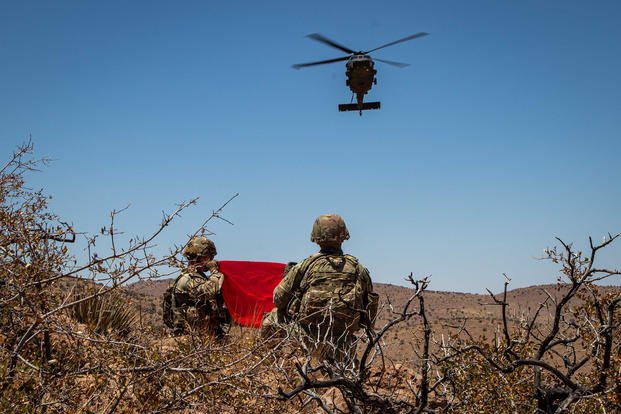The Army is heading for a major reorganization that includes eliminating at least 2,000 positions — a combination of civilian and troop roles — and cuts to planned purchases in various drone and vehicle programs that are considered outdated, according to internal documents reviewed by Military.com.
Senior Army officials outlined the plan to top officials across the force earlier this month, the documents show. The undertaking amounts to one of the Army’s most significant structural transformations in decades.
The service’s aim is to streamline the force while investing in emerging technologies that Army officials say are critical to preparing for modern conflicts, particularly in the Indo-Pacific region.
Read Next: From Star Wars to Golden Dome: Trump Pushes US Missile Shield Despite Funding and Technology Hurdles
“Every role must sharpen the spear or be cut away,” Army Secretary Dan Driscoll and Gen. Randy George, the service’s top officer, said in a joint memo to the force earlier this month.
The plan calls for eliminating 1,000 Army staff roles in the Pentagon and nixing various air cavalry squadrons — specific units were not listed — along with combining and deactivating other units that will result in reducing personnel.
For example, U.S. Army Japan Headquarters will combine with the 4th Multidomain Task Force, with the total size of that element being cut by 170 positions.
As for hardware, the Army plans to end purchases of the Gray Eagle drone and reduce purchases of the Armored Multi-Purpose Vehicle by $498 million, in addition to other cuts, according to the documents.
All commands will be directed to reduce temporary duty funding by 20%, and the service will slash funding for collective training barracks by $346 million. Those barracks are typically living quarters for major training exercises, basic training and various schools.
However, it was still unclear what the changes could mean for the total size of the Army. The plan outlines reductions to “responsibly balance end strength” in pursuit of a “leaner, more lethal Army.”
The Army declined Military.com’s request for interviews to add context to the cuts.
The service is still juggling multiple options for how many soldiers it plans to keep in its formations, with unfinished plans for cuts. In the meantime, it has already imposed limits on soldiers’ reenlistment options.
Major cuts may need to be made to pay for President Donald Trump’s Golden Dome missile defense system, which is expected to cost at least $175 billion, and cuts would likely have to come from the Army, which is the largest component of the Pentagon.
Meanwhile, recruiting has seen a dramatic upswing in 2025. That follows two years of targeted reforms including the introduction of the Future Soldier Preparatory Course. The prep courses, which help candidates meet academic and physical standards, have played a key role in revitalizing the Army’s pipeline, bringing in one-quarter of its enlistments last year.
Next year, the service plans to invest more in the program, adding the capacity for an additional 189 trainees — the program right now has the ability to graduate 23,500 recruits into basic training annually.
As part of the plan briefed to officials, the Army will also shift away from electric vehicles and fuel-saving programs, stripping all research from those efforts.
Electric vehicles have often been scoffed at by Republicans for their feasibility on the battlefield, though traditional fuel logistics are incredibly expensive and complicated, and large diesel trucks are usually very loud and not conducive to reconnaissance or low-profile operations.
“No more climate change worship. No more electric tanks,” Defense Secretary Pete Hegseth said in April at the U.S. Army War College in Pennsylvania. “No more woke bull—-.”
Here are more major cuts and changes planned by the Army:
- Cut funding for Army Prepositioned Stocks by $337 million.
- Reduce funding for the Defense Language Institute by $30 million.
- Cut the budget for the Army Geospatial Center by $50 million.
- Cut various virtual reality training programs by $52 million.
- Cease procurement of TOW wire-guided missiles equipped to vehicles and tripods for base defense.
- Terminate the pursuit of “anti-idle” technology for vehicles, which would automatically cut power to vehicles during extended idling as a means to save fuel.
- Create a skill identifier for robotics and autonomous systems-related training.
- 56th Theater Fires Command will combine with 2nd Multidomain Task Force, with a reduction of 10 positions.
- 18th Field Artillery Brigade will combine with 5th Multidomain Task Force; 20 positions will be cut.
- 4th Infantry Division’s armored brigade combat team will transition to a Stryker Brigade Combat Team.
- 3rd Cavalry Regiment will transition from Strykers to Abrams tanks, becoming an Armored Brigade Combat Team.
- Three unnamed Army National Guard units will be converted from Armored Brigade Combat Teams to Mobile Brigade Combat Teams, which are effectively standard infantry formations but with the new Infantry Squad Vehicle. Additionally, two National Guard Stryker Brigade Combat Teams will also convert to Mobile Brigade Combat Teams.
- All Army Reserve Air Cavalry and Expeditionary Combat Aviation Brigades will be deactivated.
- All MEDEVAC units will move from 15 aircraft capacity to 12.
- Army Training and Doctrine Command and Futures Command will combine into a single entity. About 400 positions will be cut.
- Cancel the planned activation of two reserve artillery units.
- Cancel the planned activation of three reserve electromagnetic warfare companies.
- Move 4th Battalion, 60th Air Defense Artillery Regiment, from Fort Sill, Oklahoma, to Fort Bliss, Texas.
- Shut down the 4th Security Force Assistance Brigade and 54th Security Force Assistance Brigade.
- Army Reserve will get two High Mobility Artillery Rocket System battalions and three HIMARS batteries.
- Establish Western Hemisphere Command by combining U.S. Army North, Forces Command and U.S. Army South; 339 positions will be eliminated.
Related: Soldiers Face Tougher Reenlistment Rules as Army Plans Troop Reductions
Story Continues
Read the full article here


